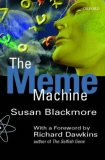What is a meme? First coined by Richard Dawkins in his 1976 study The Selfish Gene, a meme is any idea, behavior, or skill that can be transferred from one person to another by imitation: stories, fashions, inventions, recipes, songs, and ways of plowing a field, throwing a baseball, or making a sculpture. It is also one of the most important–and controversial–concepts to emerge since Darwin’s Origin of the Species.
Here, Blackmore boldly asserts: “Just as the design of our bodies can be understood only in terms of natural selection, so the design of our minds can be understood only in terms of memetic selection.” Indeed, The Meme Machine shows that once our distant ancestors acquired the crucial ability to imitate, a second kind of natural selection began: a survival of the fittest among competing ideas and behaviors. Those that proved most adaptive–making tools, for example, or using language–survived and flourished, replicating themselves in as many minds as possible. These memes then passed themselves on from generation to generation by helping to ensure that the genes of those who acquired them also survived and reproduced. Applying this theory to many aspects of human life, Blackmore brilliantly explains why we live in cities, why we talk so much, why we can’t stop thinking, why we behave altruistically, how we choose our mates, and much more. With controversial implications for our religious beliefs, our free will, and our very sense of “self,” this provocative book will be must reading any general reader or student interested in psychology, biology, or anthropology.
Dr. Blackmore herself writes:
I have always been obsessed with the big questions of life – Where did we come from? Why are we here? What is consciousness? Who, or what, am I? And found no answers. I spent twenty-five years chasing the paranormal – in vain.
Then in 1995 I was taken ill and lay in bed for many months, unable to work, or even speak much. During that time Dan Dennett’s ‘Darwin’s Dangerous Idea’ came out, and I read it with delight. My love of evolutionary theory was rekindled and I reread ‘The Selfish Gene’, in which Richard Dawkins invents the idea of memes. I had once thought this was just a fanciful analogy with genes, but soon began to see it as a theory that could transform our understanding of mind and society. As I lay in bed, unable to do anything else, I thought my way systematically through the implications of the meme concept for the evolution of the brain, the origins of language, the nature of human co-operation and altruism, and the power of religions.
The more I thought about memes, the more I realised that they, not us, are the driving force in our world. You could say that they, not the genes, needed big brains for their own replication. They, not us, have created books and photocopiers, phones and faxes, for their own propagation. They, not us, have designed the Internet, and will determine its effects on the world — and on us.
I have practised meditation for many years, and wondered who is fighting whom in the battle to calm the mind. Now I see the mess of our minds as a battle between the memes – and we, our precious selves, as a complex of co-adapted memes – a memeplex. We may think we are an independent agent with consciousness and free will, but that is just illusion. Taking the ‘meme’s eye view’ really can transform your world.
I soon realised that there was no serious book on the science of memetics and I decided to write one. Fortunately I recovered and did just that.




